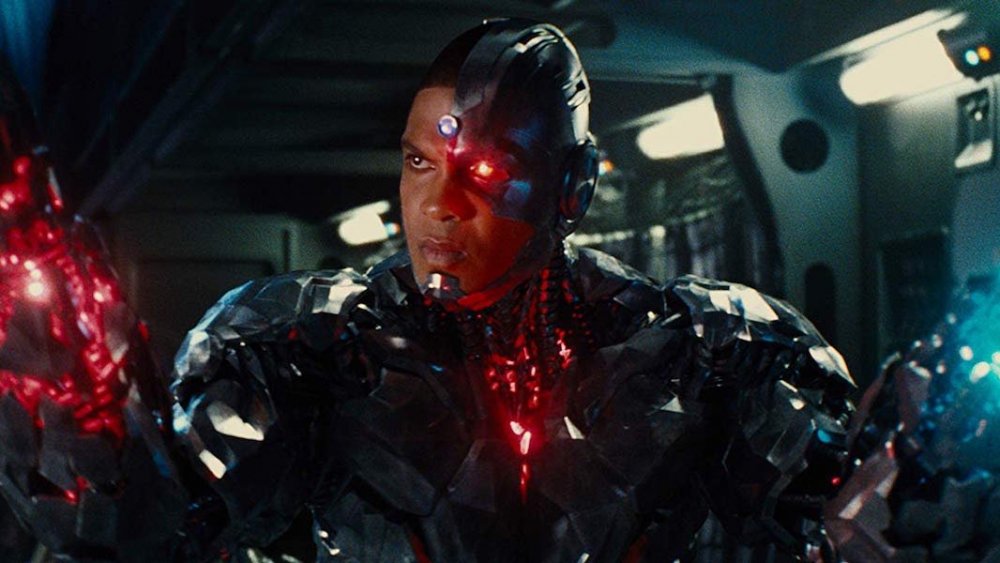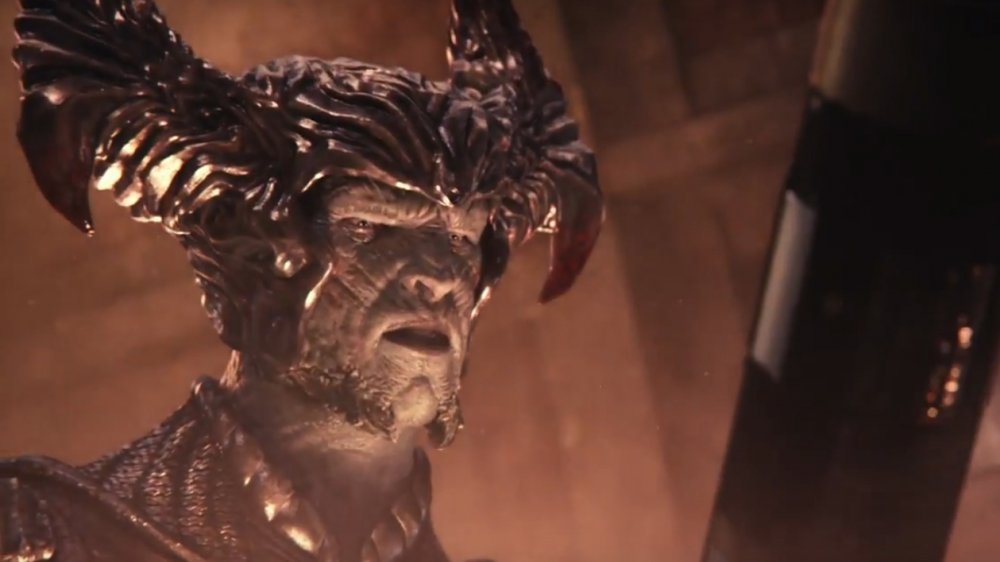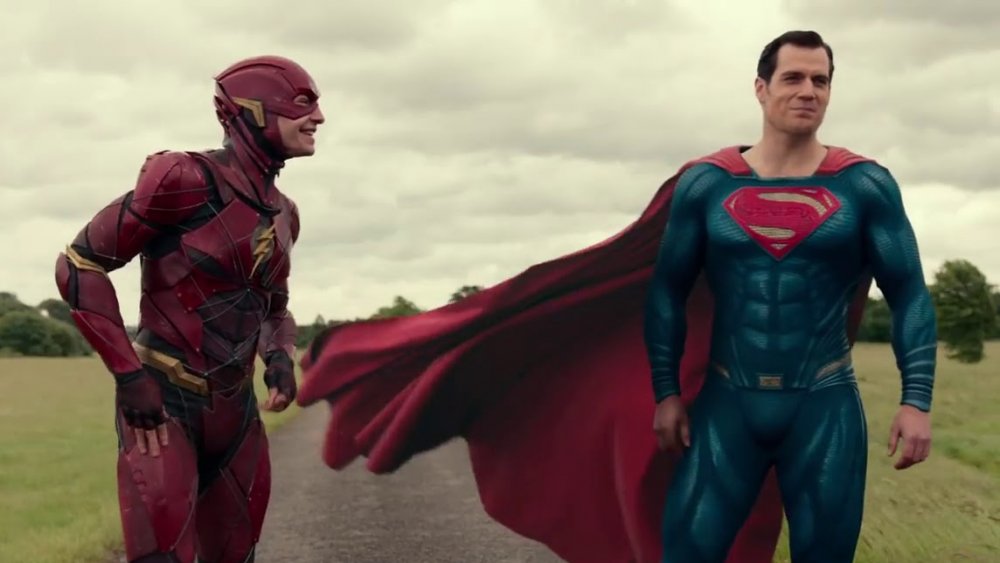The 3 Biggest Rumored Changes Coming To The Justice League Director's Cut
Three years on, the appeals to once-seemingly-deaf ears have finally been heard. The much-discussed Snyder Cut of Justice League will see the light of day. It's not quite as simple as the internet might have led you to believe, however: Snyder will be getting around $30 million to take unfinished footage and put it through post-production VFX and re-editing, which is why we won't be seeing it premiere on HBO Max until 2021.
This process will likely remove at least some of the script changes Joss Whedon added or otherwise modified when he took over finishing the project after Snyder had to step down following the death of his daughter. Chief complaints about the theatrical version of Justice League focus on those presumed changes by Whedon to alter the tone of the film to be more lighthearted — although that may have been something Warner Bros. instructed Snyder to do when he began writing Justice League with Chris Terrio in the wake of Batman v Superman's release. If true, that could have been interpreted in many different ways, especially with Whedon and Snyder being such different creative minds.
In general, the overarching plot of Justice League hews to Snyder's original ideas, but permitting Snyder to assemble something closer to his intended final cut will fulfill his creative vision in better detail. Over the years, bits and pieces have snuck about what Snyder had included in his original rough cut presented to Warner Bros. Let's go over the most radical differences we can look forward to seeing re-interpreted — or, perhaps, originally meant to be presented — when HBO releases it onto its new streaming platform.
The real deal with Darkseid
Steppenwolf (portrayed by Ciaran Hinds) is the theatrical cut's only antagonist, but Snyder actually intended for him to merely be a lackey showing up as an avatar for The Big Guy, Darkseid.
In Batman v Superman, Darkseid is briefly shown as part of an apocalyptic nightmare Bruce Wayne (Ben Affleck) experiences as a potential vision of the future. Snyder did have an overarching story to put into play in Justice League that was diminished by Whedon's edits for both tone and business reasons, as Warner Bros.' priorities for its franchise first began to shift towards the standalone films we've been seeing in the years since. Theatrical-cut Steppenwolf even makes fleeting mention of his boss. It'd be easy to miss, and that's part of the problem. Although Steppenwolf is a pre-existing character in DC canon, he's not nearly as famous as Darkseid is — and frankly, that can make for an underwhelming villain in a movie purporting to be as much of an ultimate climax as marketing for Justice League wanted us to believe.
How this plays out in Snyder's second go-around remains to be seen. Once upon a time, Justice League was supposed to have multiple parts, akin to your Infinity War/Endgame situation, and Darkseid was only meant to make a few appearances in the first film to whet the appetite. That dream is now very, very dead, so including this material meant to be a cliffhanger now means it will have nowhere to go, either. Perhaps it will simply be put in as originally intended as a what-could-have-been retrospective. That seems a bit depressing, though.
A brighter spotlight for the new guys
Another complaint with the theatrical cut of Justice League is its pacing. It wanted to do a lot in its tight two-hour runtime (Snyder's version, which he posted a picture of in the past, runs for 214 minutes), including introducing characters we knew were coming, but had not gotten the benefit of solo movies of their own. Barry Allen, a.k.a. the Flash (Ezra Miller), and Victor Stone, a.k.a. Cyborg (Ray Fisher), both got a bit of a rapid run-down in Justice League. At least with Aquaman (Jason Momoa), we did get that standalone film, so that's been mitigated, but neither of the team's youngest members got a whole lot of time on screen to really establish themselves outside of the strict necessities of plot. Bits of banter peeked in here and there, but banter does not a characterization make. Allen, for example, was supposed to have his love interest appear in a scene that was ultimately cut. Ezra Miller's performance certainly felt like a fully-lived-in character, so hopefully a little more about himself and his dad's framing for murder will appear in the director's cut.
Cyborg, too, had much more to do in the original script alongside his father. There was some content in the Justice League theatrical cut about how Cyborg's dad created him using the Mother Box, but the deleted scenes include a full-on fight with Steppenwolf at S.T.A.R Labs, where Cyborg's dad worked and researched the Mother Box. An unspecified flashback scene with Cyborg's mother was reportedly cut, too. Supposedly, Cyborg also had more expositional work to do in general since his existence is so entwined with one of the Mother Boxes.
Of all the changes said to be featured in the Snyder Cut of Justice League, this would be particularly intriguing to see given thaat the Cyborg solo film that had been originally announced in 2014 never came to fruition and probably never will.
Climax, interrupted
The theatrical climax of Justice League has the team (minus Superman) struggle to stop Steppenwolf before uniting the three Mother Boxes way out in the middle of nowhere in Russia. All seems lost until the deus ex machina arrival of Superman, who just freshly downloaded all his memories after going home to reflect with Lois Lane. It's very tidy, they save the day, Clark Kent makes an adorable joke about not understanding what's going on, and everybody high fives before leaving for pizza.
If all that felt a touch too jocular for you, that's because Whedon pretty much overhauled the entire third act of Justice League was pretty much overhauled by Whedon. He reportedly added 80 pages to the script during his re-write, and it seems like the bulk of those changes were put in the latter half. Part of that is to fix the Darkseid Problem we mentioned earlier — simplifying the conflict since the idea of any Justice League sequels died (due to a whole bunch of reasons that Synder's personal tragedy and departure only sealed the deal on rather than caused directly).
Snyder's Justice League climax is reportedly quite different. For one, it intended to follow through on that bad-ending scenario Bruce Wayne foresaw in Batman v Superman; the resurrection of Superman goes poorly, he turns to Steppenwolf's side and dons the infamous black version of his outfit, and assists Steppenwolf/Darkseid with bringing Earth to its knees. The only thing that can fix it is — you guessed it — time travel. But the basic fact of these rearranged canon pieces hide a more nuanced truth.
There are differences, but what's the difference?
The most important bit about the climax — which plays out in smaller ways across the rest of the narrative — is that in the midst of all the time-travel plots and villainous posing and world-ending scenarios, Cyborg has some kind of self-actualization moment as he fights with the Mother Boxes where he confronts his trauma and body dysmorphia. Once again, this is an important completion of a character arc we didn't get in the theatrical version of Justice League, and since there will be no Cyborg movie, this is going to be the only opportunity to see it through for an audience to see.
This isn't just replacing a bad guy or punching up a fight — it's a fundamentally different scenario altogether, with critical emotional arcs at stake. For all the overwrought extremes that the #ReleasetheSnyderCut campaign went to, there is indeed truth to the idea that Snyder did want to present something thematically different from what went to theaters in the summer of 2017, and had specific priorities to focus on things that Warner Bros. and Whedon didn't have.
Nobody is necessarily at fault here — least of all Snyder, who left for extremely understandable reasons. Warner Bros. had a date to keep in an extraordinarily competitive film market, and Whedon had a very limited amount of time and money to rearrange and reshoot a film that was entering post-production. There was no winning in that time and place for anybody.
Releasing the Snyder Cut now won't fix anything, either. It won't resurrect Justice League 2, or Cyborg, or Batfleck, but there's an important argument to be made here for the right of a creator to present his vision — especially when the film has been through as much and as colorful critique as Justice League has been.




